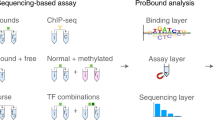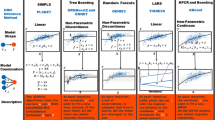Abstract
High-density short oligonucleotide microarrays have become a widely used tool for measuring gene expression on a large scale1,2. However, details of the mechanism of binding on microarrays remain unclear3. Short oligonucleotide probes currently synthesized on microarrays are often ineffective as a result of limited sequence specificity or low sensitivity. Here, we describe a model of binding interactions on microarrays that reveals how probe signals depend on probe sequences and why certain probes are ineffective. The model indicates that the amount of nonspecific binding can be estimated from a simple rule. Using this model, we have developed an improved measure of gene expression for use in data analysis.
This is a preview of subscription content, access via your institution
Access options
Subscribe to this journal
Receive 12 print issues and online access
$209.00 per year
only $17.42 per issue
Buy this article
- Purchase on Springer Link
- Instant access to full article PDF
Prices may be subject to local taxes which are calculated during checkout



Similar content being viewed by others
References
Lockhart, D.J. & Winzeler, E.A. Genomics, gene expression and DNA arrays. Nature 405, 827–836 (2000).
van Berkum, N.L. & Holstege, F.C. DNA microarrays: raising the profile. Curr. Opin. Biotechnol. 12, 48–52 (2001).
Southern, E., Mir, K. & Shchepinov, M. Molecular interactions on microarrays. Nat. Genet. 21, 5–9 (1999).
Lockhart, D.J. et al. Expression monitoring by hybridization to high-density oligonucleotide arrays. Nat. Biotechnol. 14, 1675–1680 (1996).
Zhou, Y. & Abagyan, R. Match-Only Integral Distribution (MOID) Algorithm for high-density oligonucleotide array analysis. BMC Bioinformatics 3, 3 (2002).
Naef, F., Hacker, C.R., Patil, N. & Magnasco, M. Characterization of the expression ratio noise structure in high-density oligonucleotide arrays. Genome Biol. 3, research0018 (2002).
Li, C. & Wong, W.H. Model-based analysis of oligonucleotide arrays: expression index computation and outlier detection. Proc. Natl. Acad. Sci. USA 98, 31–36 (2001).
Sugimoto, N. et al. Thermodynamic parameters to predict stability of RNA/DNA hybrid duplexes. Biochemistry 34, 11211–11216 (1995).
Breslauer, K.J., Frank, R., Blocker, H. & Marky, L.A. Predicting DNA duplex stability from the base sequence. Proc. Natl. Acad. Sci. USA 83, 3746–3750 (1986).
Shchepinov, M.S., Case-Green, S.C. & Southern, E.M. Steric factors influencing hybridisation of nucleic acids to oligonucleotide arrays. Nucleic Acids Res. 25, 1155–1161 (1997).
Forman, J.E., Walton, I.D., Stern, D., Rava, R.P. & Trulson, M.O. in Molecular Modeling of Nucleic Acids vol. 682 206–228 (American Chemical Society, Washington, DC, USA, 1998).
Lazaridis, E.N., Sinibaldi, D., Bloom, G., Mane, S. & Jove, R. A simple method to improve probe set estimates from oligonucleotide arrays. Math. Biosci. 176, 53–58 (2002).
Lemon, W.J., Palatini, J.J.T., Krahe, R. & Wright, F.A. Theoretical and experimental comparisons of gene expression indexes for oligonucleotide arrays. Bioinformatics 18, 1470–1476 (2002).
Chu, T.M., Weir, B. & Wolfinger, R. A systematic statistical linear modeling approach to oligonucleotide array experiments. Math. Biosci. 176, 35–51 (2002).
Chudin, E. et al. Assessment of the relationship between signal intensities and transcript concentration for Affymetrix GeneChip arrays. Genome Biol. 3, research0005 (2002).
Irizarry, R.A. et al. Summaries of Affymetrix GeneChip probe level data. Nucleic Acids Res. 31, e15 (2003).
Dudley, A.M., Aach, J., Steffen, M.A. & Church, G.M. Measuring absolute expression with microarrays with a calibrated reference sample and an extended signal intensity range. Proc. Natl. Acad. Sci. USA 99, 7554–7559 (2002).
Yuen, T., Wurmbach, E., Pfeffer, R.L., Ebersole, B.J. & Sealfon, S.C. Accuracy and calibration of commercial oligonucleotide and custom cDNA microarrays. Nucleic Acids Res. 30, e48 (2002).
Li, F. & Stormo, G.D. Selection of optimal DNA oligos for gene expression arrays. Bioinformatics 17, 1067–1076 (2001).
Acknowledgements
We thank Keith Baggerly, Kevin R. Coombes, Kenneth Hess, Jan Hermans, Roberto Carta, Jing Wang, David Gold, LeeAnn Chastain and Zoltan Szallasi for suggestions on the manuscript and Nobert Wilke and Mini Kapoor for technical support. This work was supported by The University of Texas M.D. Anderson Cancer Center, a grant (DA14167) from the National Institute for Drug Abuse and funding from the State of California.
Author information
Authors and Affiliations
Corresponding author
Ethics declarations
Competing interests
The authors declare no competing financial interests.
Rights and permissions
About this article
Cite this article
Zhang, L., Miles, M. & Aldape, K. A model of molecular interactions on short oligonucleotide microarrays. Nat Biotechnol 21, 818–821 (2003). https://doi.org/10.1038/nbt836
Received:
Accepted:
Published:
Issue Date:
DOI: https://doi.org/10.1038/nbt836
This article is cited by
-
PDEGEM: Modeling non-uniform read distribution in RNA-Seq data
BMC Medical Genomics (2015)
-
Microarray-based large scale detection of single feature polymorphism in Gossypium hirsutum L.
Journal of Genetics (2015)
-
Intra-platform comparison of 25-mer and 60-mer oligonucleotide Nimblegen DNA microarrays
BMC Research Notes (2013)
-
Adjustment method for microarray data generated using two-cycle RNA labeling protocol
BMC Genomics (2013)
-
Hybridization and amplification rate correction for affymetrix SNP arrays
BMC Medical Genomics (2012)



